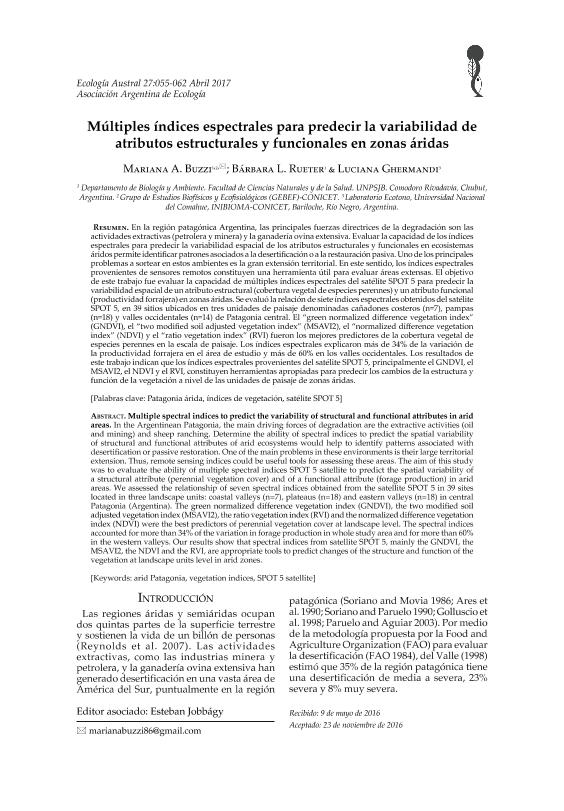Artículo
En la región patagónica Argentina, las principales fuerzas directrices de la degradación son las actividades extractivas (petrolera y minera) y la ganadería ovina extensiva. Evaluar la capacidad de los índices espectrales para predecir la variabilidad espacial de los atributos estructurales y funcionales en ecosistemas áridos permite identificar patrones asociados a la desertificación o a la restauración pasiva. Uno de los principales problemas a sortear en estos ambientes es la gran extensión territorial. En este sentido, los índices espectrales provenientes de sensores remotos constituyen una herramienta útil para evaluar áreas extensas. El objetivo de este trabajo fue evaluar la capacidad de múltiples índices espectrales del satélite SPOT 5 para predecir la variabilidad espacial de un atributo estructural (cobertura vegetal de especies perennes) y un atributo funcional (productividad forrajera) en zonas áridas. Se evaluó la relación de siete índices espectrales obtenidos del satélite SPOT 5, en 39 sitios ubicados en tres unidades de paisaje denominadas cañadones costeros (n=7), pampas (n=18) y valles occidentales (n=14) de Patagonia central. El “green normalized difference vegetation index” (GNDVI), el “two modified soil adjusted vegetation index” (MSAVI2), el “normalized difference vegetation index” (NDVI) y el “ratio vegetation index” (RVI) fueron los mejores predictores de la cobertura vegetal de especies perennes en la escala de paisaje. Los índices espectrales explicaron más de 34% de la variación de la productividad forrajera en el área de estudio y más de 60% en los valles occidentales. Los resultados de este trabajo indican que los índices espectrales provenientes del satélite SPOT 5, principalmente el GNDVI, el MSAVI2, el NDVI y el RVI, constituyen herramientas apropiadas para predecir los cambios de la estructura y función de la vegetación a nivel de las unidades de paisaje de zonas áridas. In the Argentinean Patagonia, the main driving forces of degradation are the extractive activities (oil and mining) and sheep ranching. Determine the ability of spectral indices to predict the spatial variability of structural and functional attributes of arid ecosystems would help to identify patterns associated with desertification or passive restoration. One of the main problems in these environments is their large territorial extension. Thus, remote sensing indices could be useful tools for assessing these areas. The aim of this study was to evaluate the ability of multiple spectral indices SPOT 5 satellite to predict the spatial variability of a structural attribute (perennial vegetation cover) and of a functional attribute (forage production) in arid areas. We assessed the relationship of seven spectral indices obtained from the satellite SPOT 5 in 39 sites located in three landscape units: coastal valleys (n=7), plateaus (n=18) and eastern valleys (n=18) in central Patagonia (Argentina). The green normalized difference vegetation index (GNDVI), the two modified soil adjusted vegetation index (MSAVI2), the ratio vegetation index (RVI) and the normalized difference vegetation index (NDVI) were the best predictors of perennial vegetation cover at landscape level. The spectral indices accounted for more than 34% of the variation in forage production in whole study area and for more than 60% in the western valleys. Our results show that spectral indices from satellite SPOT 5, mainly the GNDVI, the MSAVI2, the NDVI and the RVI, are appropriate tools to predict changes of the structure and function of the vegetation at landscape units level in arid zones.
Múltiples índices espectrales para predecir la variabilidad de atributos estructurales y funcionales en zonas áridas
Título:
Multiple spectral indices to predict the variability of structural and functional attributes in arid areas
Fecha de publicación:
04/2017
Editorial:
Asociación Argentina de Ecología
Revista:
Ecología Austral
ISSN:
1667-782X
e-ISSN:
0327-5477
Idioma:
Español
Tipo de recurso:
Artículo publicado
Clasificación temática:
Resumen
Palabras clave:
Patagonia Árida
,
Índices de Vegetación
,
Satélite Spot 5
Archivos asociados
Licencia
Identificadores
Colecciones
Articulos(CCT-CENPAT)
Articulos de CTRO.CIENTIFICO TECNOL.CONICET - CENPAT
Articulos de CTRO.CIENTIFICO TECNOL.CONICET - CENPAT
Articulos(INIBIOMA)
Articulos de INST. DE INVEST.EN BIODIVERSIDAD Y MEDIOAMBIENTE
Articulos de INST. DE INVEST.EN BIODIVERSIDAD Y MEDIOAMBIENTE
Citación
Buzzi, Mariana Andrea; Rueter, Barbara Lisa; Ghermandi, Luciana; Múltiples índices espectrales para predecir la variabilidad de atributos estructurales y funcionales en zonas áridas; Asociación Argentina de Ecología; Ecología Austral; 27; 1; 4-2017; 55-62
Compartir




